AWM52 1/11/18/1 - 1946, part 1, Headquarters London Victory March, Contingent list - Part 7
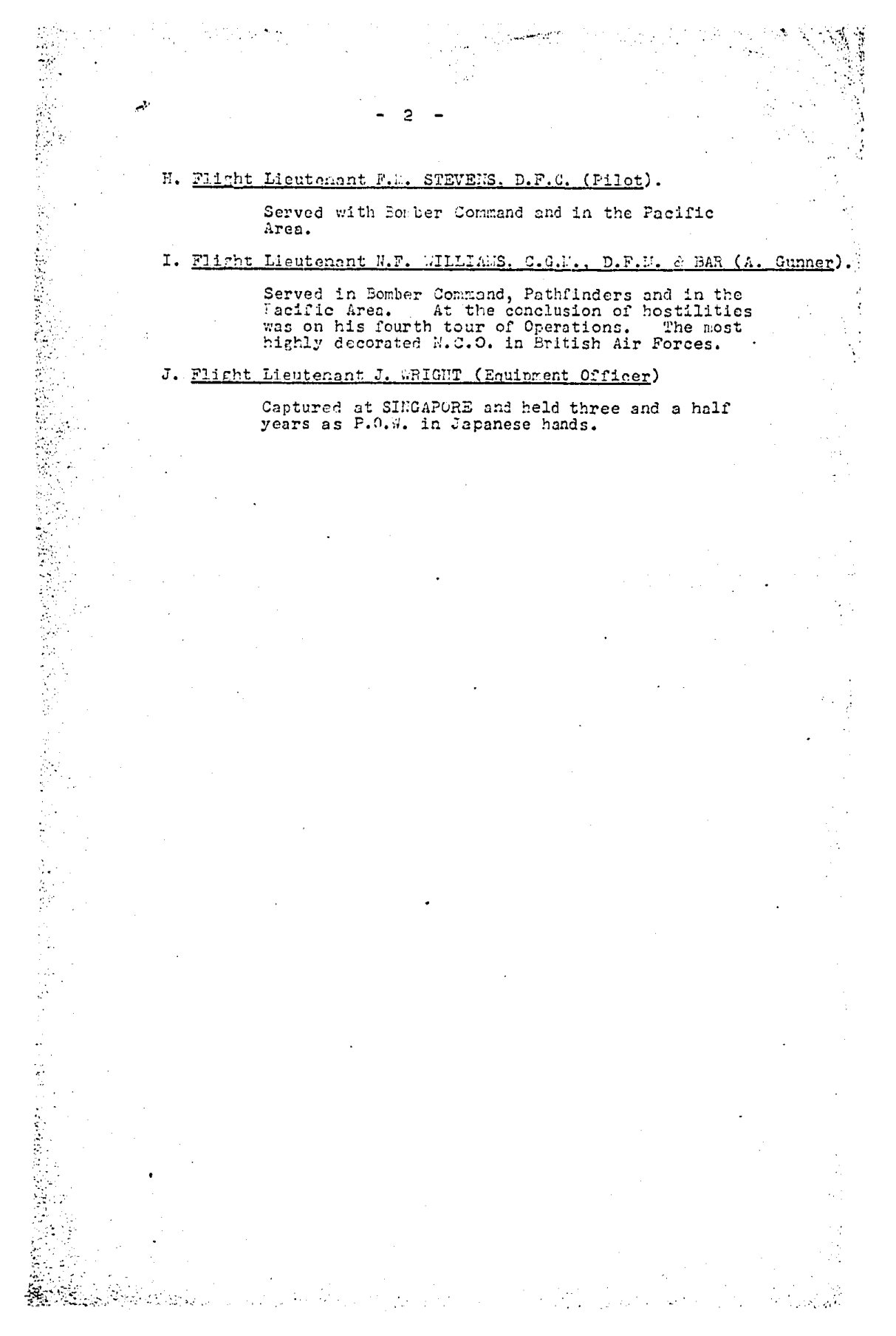
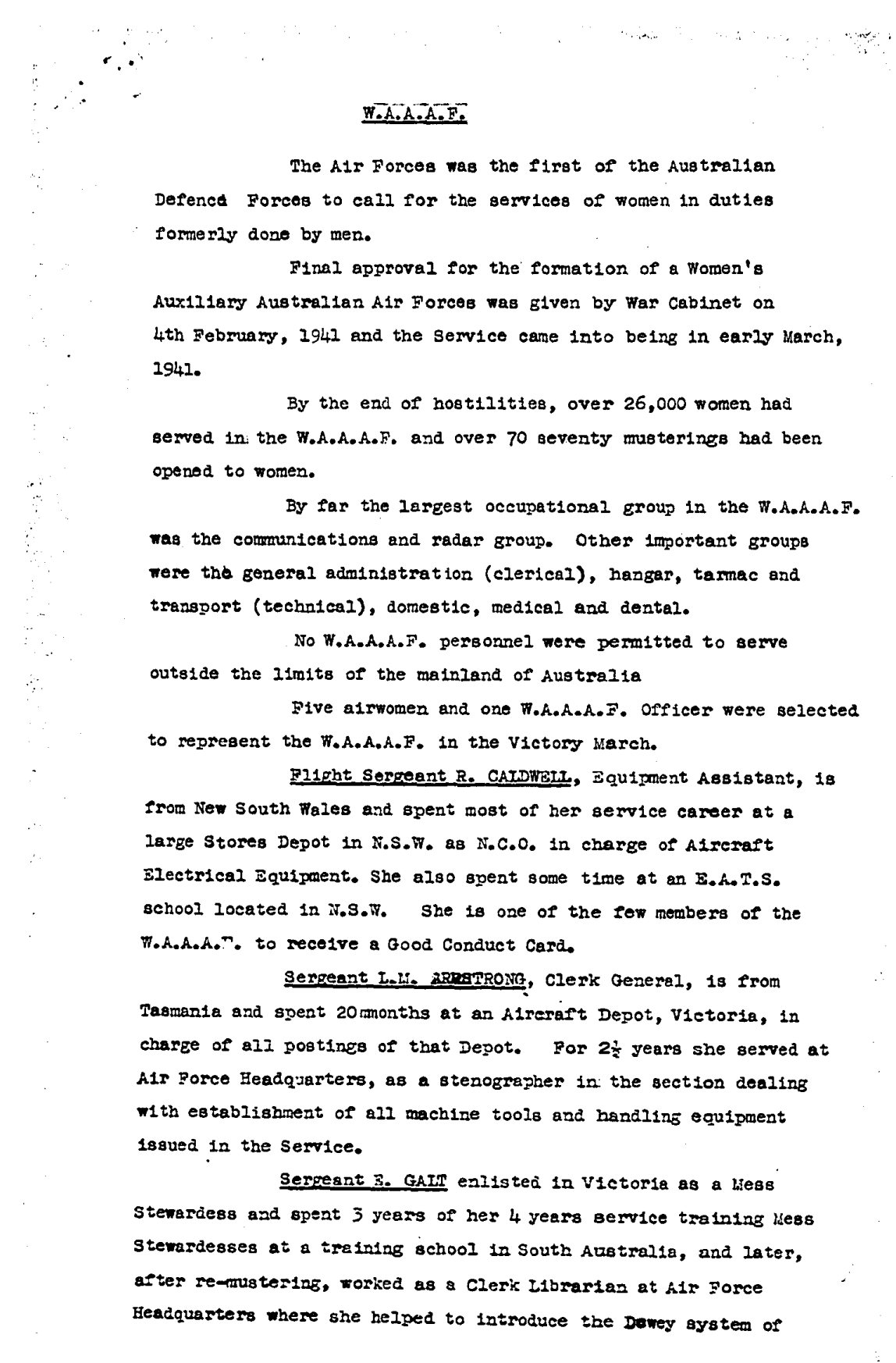
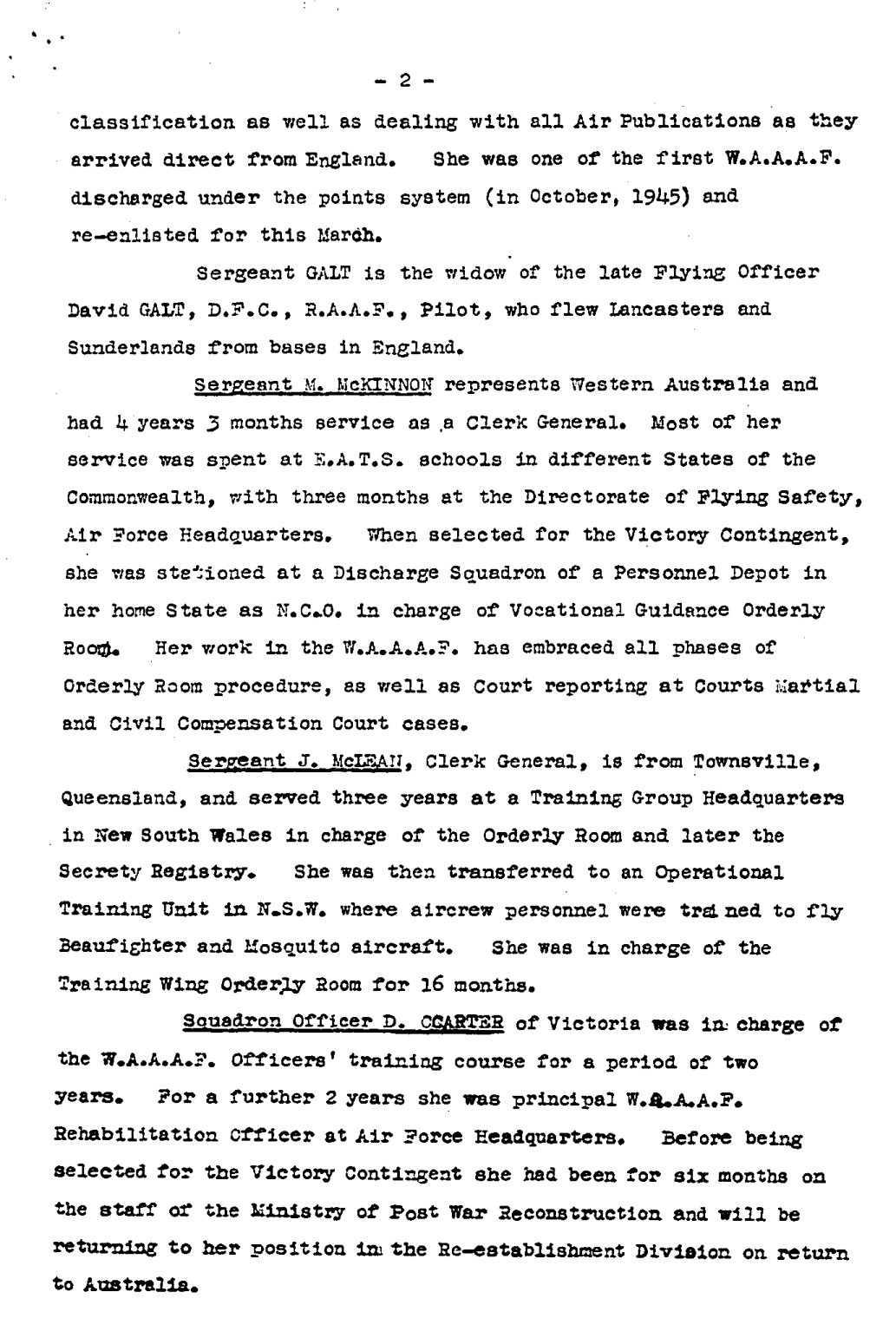

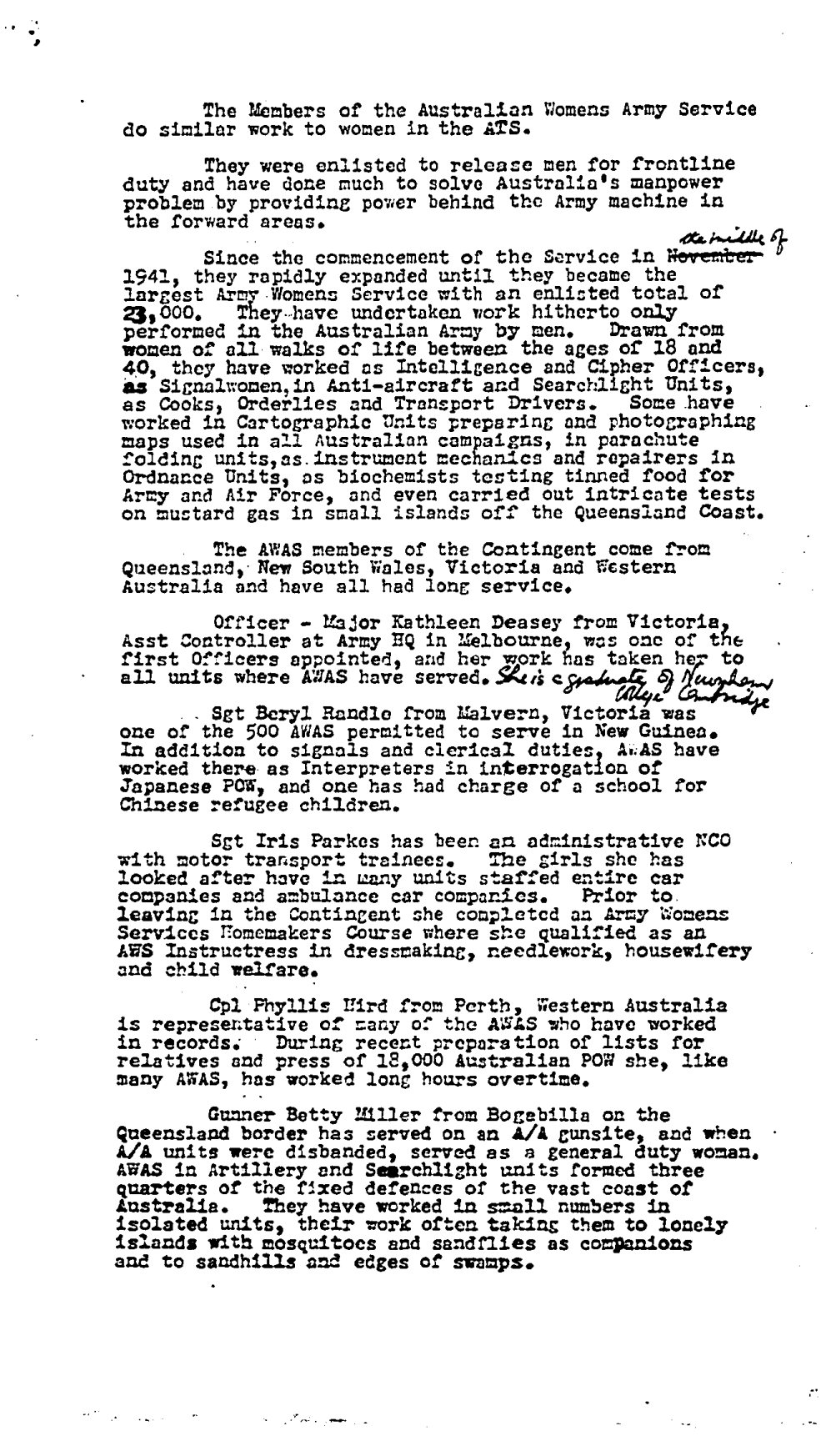
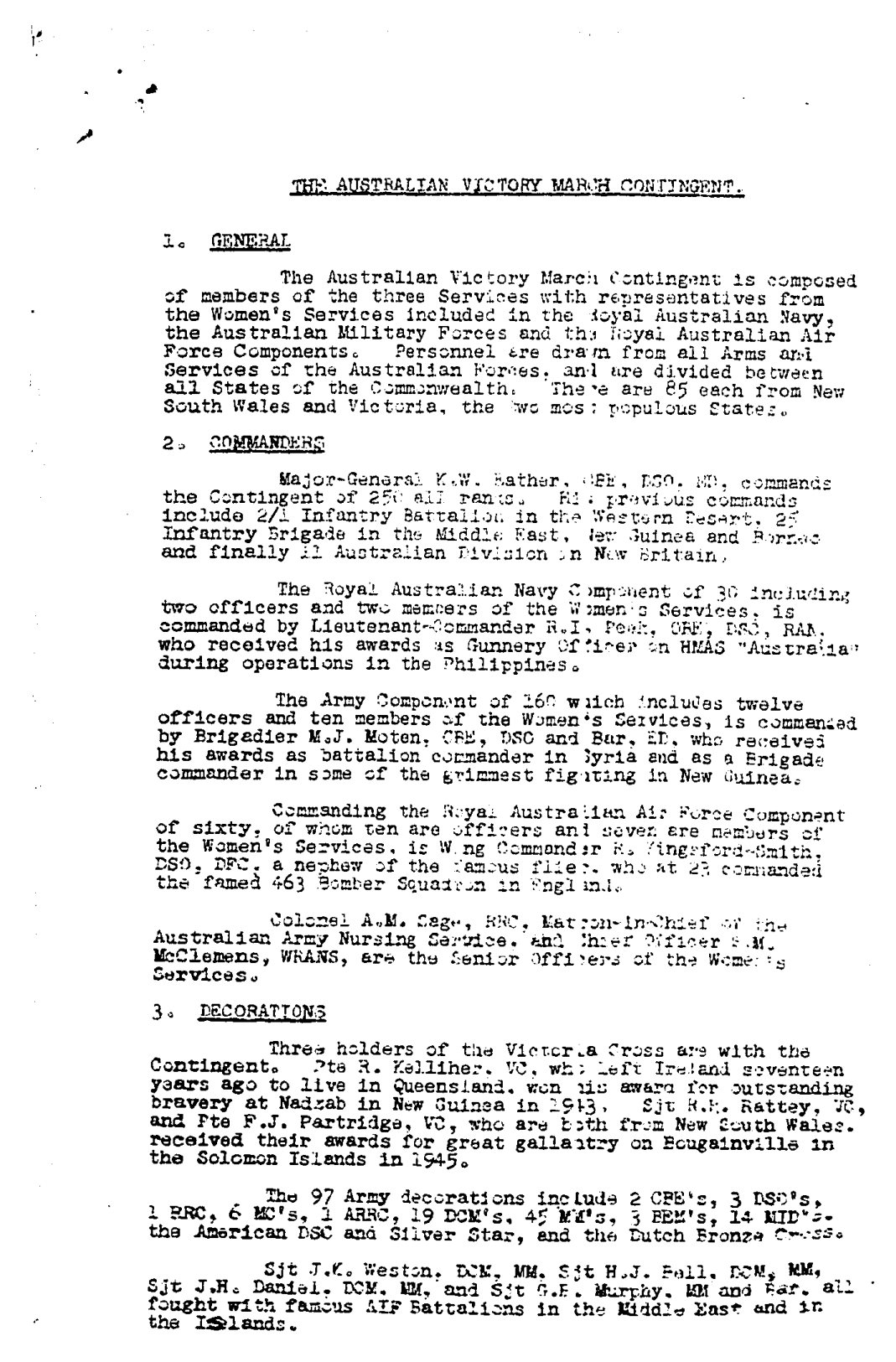


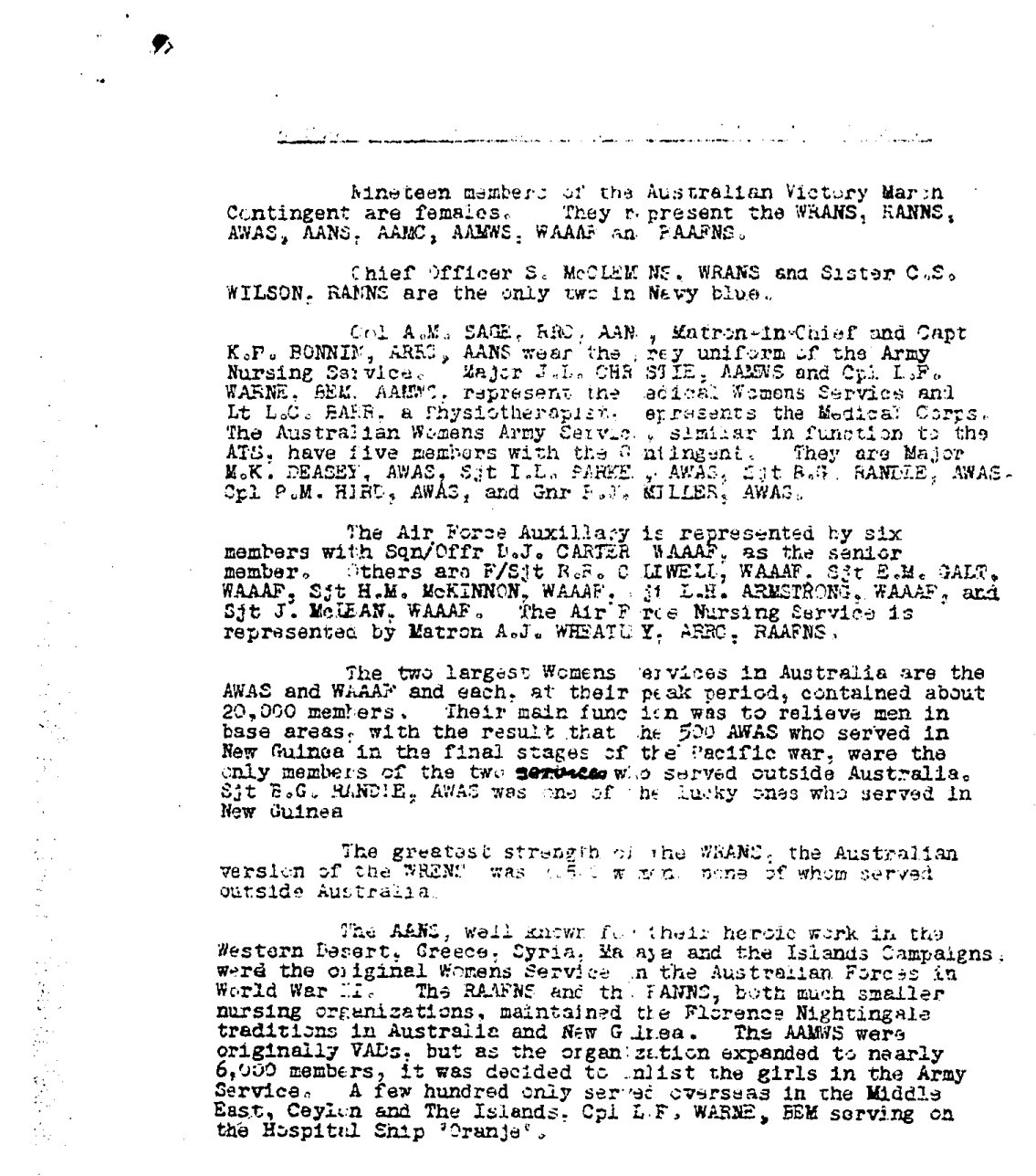
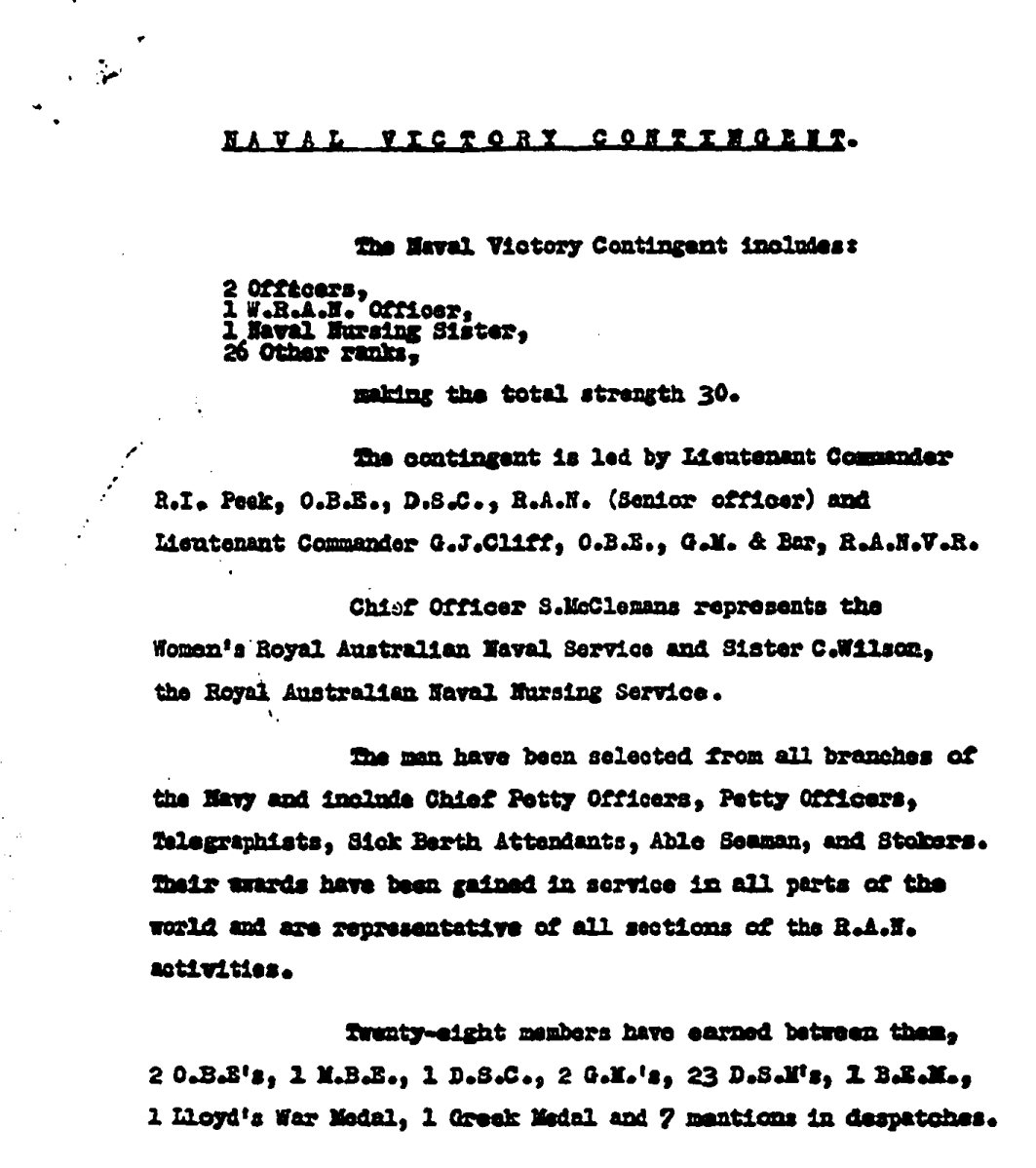
-2-
H. Flight Lieutenant F.M. STEVENS. D.F.C. (Pilot).
Served with Bomber Command and in the Pacific
Area.
I. Flight Lieutenant N.F. WILLIAMS. C.G.M., D.F.M. & BAR (A. Gunner).
Served in Bomber Command, Pathfinders and in the
Pacific Area. At the conclusion of hostilities
was on his fourth tour of Operations. The most
highly decorated N.C.O. in British Air Forces.
J. Flight Lieutenant J. WRICHT (Equipment Officer)
Captured at SINGAPORE and held three and a half
years as P.O.W. in Japanese hands.
W.A.A.A.F.
The Air Forces was the first of the Australian
Defence Forces to call for the services of women in duties
formerly done by men.
Final approval for the formation of a Women's
Auxiliary Australian Air Forces was given by War Cabinet on
4th February, 1941 and the Service came into being in early March,
1941.
By the end of hostilities, over 26,000 women had
served in the W.A.A.A.F. and over 70 seventy musterings had
been opened to women.
By far the largest occupational group in the W.A.A.A.F.
was the communications and radar group. Other important groups
were the general administration (clerical), hangar, tarmac and
transport (technical), domestic, medical and dental.
No W.A.A.A.F. personnel were permitted to serve
outside the limits of the mainland of Australia
Five airwomen and one W.A.A.A.F. Officer were selected
to represent the W.A.A.A.F. in the Victory March.
Flight Sergeant R. CALDWELL, Equipment Assistant, is
from New South Wales and spent most of her service career at a
large Stores Depot in N.S.W. as N.C.O. in charge of Aircraft
Electrical Equipment. She also spent some time at an E.A.T.S.
school located in N.S.W. She is one of the few members of the
W.A.A.A.F. to receive a Good Conduct Card.
Sergeant L.M. ARMSTRONG, Clerk General, is from
Tasmania and spent 20 months at an Aircraft Depot, Victoria, in
charge of all postings of that Depot. For 2 1/2 years she served at
Air Force Headquarters, as a stenographer in the section dealing
with establishment of all machine tools and handling equipment
issued in the Service.
Sergeant E. GALT enlisted in Victoria as a Mess
Stewardess and spent 3 years of her 4 years service training Mess
Stewardesses at a training school in South Australia, and later,
after re-mustering, worked as a Clerk Librarian at Air Force
Headquarters where she helped to introduce the Dewey system of
-2-
classification as well as dealing with all Air Publications as they
arrived direct from England. She was one of the first W.A.A.A.F.
discharged under the points system (in October, 1945) and
re-enlisted for this March.
Sergeant GALT is the widow of the late Flying Officer
David GALT, D.F.C., R.A.A.F., Pilot, who flew Lancasters and
Sunderlands from bases in England.
Sergeant M. McKINNON represents Western Australia and
had 4 years 3 months service as a Clerk General. Most of her
service was spent at E.A.T.S. schools in different States of the
Commonwealth, with three months at the Directorate of Flying Safety,
Air Force Headquarters. When selected for the Victory Contingent,
she was stationed at a Discharge Squadron of a Personnel Depot in
her home State as N.C.O. in charge of Vocational Guidance Orderly
Room. Her work in the W.A.A.A.F. has embraced all phases of
Orderly Room procedure, as well as Court reporting at Courts Martial
and Civil Compensation Court cases.
Sergeant J. McLEAN, Clerk General, is from Townsville,
Queensland, and served three years at a Training Group Headquarters
in New South Wales in charge of the Orderly Room and later the
Secrety Registry. She was then transferred to an Operational
Training Unit in N.S.W. where aircrew personnel were trained to fly
Beaufighter and Mosquito aircraft. She was in charge of the
Training Wing Orderly Room for 16 months.
Squadron Officer D. CCARTER of Victoria was in charge of
the W.A.A.A.F. Officers' training course for a period of two
years. For a further 2 years she was principal W.A.A.A.F.
Rehabilitation Officer at Air Force Headquarters. Before being
selected for the Victory Contingent she had been for six months on
the staff of the Ministry of Post War Reconstruction and will be
returning to her position in the Re-establishment Division on return
to Australia.
R.A.A.F. NURSING SERVICE.
The R.A.A.F. Nursing Service, formed in July, 1940, on the
lines of the Princess Mary Nursing Service, grew from the twelve
initial members to nearly 700 at the cessation of hostilities.
Members of the R.A.A.F.N.S. served on Air Force Stations
throughout the Commonwealth of Australia, in New Guinea and on
transport duty to England, Canada and America.
In 1944 the Medical Evacuation Air Transport Unit was formed
and specially trained Flight Sisters assisting in this work have
served in New Guinea and the surrounding islands and assisted in
the evacuation of P.O.W.s from Singapore and the surrounding
Japanese prison camps. In thousands of flying hours two only of
these sisters were lost whilst on duty.
Matron Jean WHEATLEY, the only representative of the R.A.A.F.N.S.
with the Australian Victory Contingent, was the first member of
this service to receive a decoration, being made an Associate of
the Royal Red Cross whilst serving in New Guinea in 1943.
Matron WHEATLEY, since joining the service in 1941, has
served in Australia, on transport duty to America, and was in charge
of the first members of the bR.A.A.F.N.S. to leave Australia as
a Unit, serving in New Guinea from 1942-1944.
The Members of the Australian Womens Army Service
do similar work to women in the ATS.
They were enlisted to release men for frontline
duty and have done much to solve Australia's manpower
problem by providing power behind the Army machine in
the forward areas.
Since the commencement of the Service in November ^ the middle of
1941, they rapidly expanded until they became the
largest Army Womens Service with an enlisted total of
23,000. They have undertaken work hitherto only
performed in the Australian Army by men. Drawn from
women of all walks of life between the ages of 18 and
40, they have worked as Intelligence and Cipher Officers,
as Signalwomen, in Anti-aircraft and Searchlight Units,
as Cooks, Orderlies and Transport Drivers. Some have
worked in Cartographic Units preparing and photographing
maps used in all Australian campaigns, in parachute
folding units, as instrument mechanics and repairers in
Ordnance Units, as biochemists testing tinned food for
Army and Air Force, and even carried out intricate tests
on mustard gas in small islands off the Queensland Coast.
The AWAS members of the Contingent come from
Queensland, New South Wales, Victoria and Western
Australia and have all had long service.
Officer - Major Kathleen Deasey from Victoria.
Asst Controller at Army HQ in Melbourne, was one of the
first Officers appointed, and her work has taken her to
all units where AWAS have served. She is a graduate of Newnham College Cambridge
Sgt Beryl Randle from Malvern, Victoria was
one of the 500 AWAS permitted to serve in New Guinea.
In addition to signals and clerical duties, AWAS have
worked there as Interpreters in interrogation of
Japanese POW, and one has had charge of a school for
Chinese refugee children.
Sgt Iris Parkes has been an administrative NCO
with motor transport trainees. The girls she has
looked after have in many units staffed entire car
companies and ambulance car companies. Prior to
leaving in the Contingent she completed an Army Womens
Services Homemakers Course where she qualified as an
AWS Instructress in dressmaking, needlework, housewifery
and child welfare.
Cpl Phyllis Hird from Perth, Western Australia
is representative of any of the AWAS who have worked
in records. During recent preparation of lists for
relatives and press of 18,000 Australian POW she, like
many AWAS, has worked long hours overtime.
Gunner Betty Miller from Bogabilla on the
Queensland border has served on an A/A gunsite, and when
A/A units were disbanded, served as a general duty woman.
AWAS in Artillery and Searchlight units formed three
quarters of the fixed defences of the vast coast of
Australia.
They have worked in small numbers in
isolated units, their work often taking them to lonely
islands with mosquitoes and sandflies as companions
and to sandhills and edges of swamps.
THE AUSTRALIAN VICTORY MARCH CONTINGENT.
1. GENERAL
The Australian Victory March Contingent is composed
of members of the three Services with representatives from
the Women's Services included in the Royal Australian Navy,
the Australian Military Forces and the Royal Australian Air
Force Components. Personnel are drawn from all Arms and
Services of the Australian Forces, and are divided between
all States of the Commonwealth. There are 85 each from New
South Wales and Victoria, the two most populous States.
2. COMMANDERS
Major-General K.W. Eather, OBE, DS,. MD, commands
the Contingent of 250 all ranks. His previous commands
include 2/1 Infantry Battalion in the Western Desert. 25
Infantry Brigade in the Middle East, New Guinea and Borneo
and finally 11 Australian Division in New Britain,
The Royal Australian Navy Component of 30 including
two officers and two members of the Women's Services, is
commanded by Lieutenant-Commander R.I. Peek, OBE, DSC, RAN.
who received his awards as Gunnery Officer on HMAS "Australia"
during operations in the Philippines.
The Army Component of 160 which includes twelve
officers and ten members of the Women's Services, is commanded
by Brigadier M.J. Moten, CBE, DSC and Bar, ED. who received
his awards as battalion commander in Syria and as a Brigade
commander in some of the grimmest fighting in New Guinea.
Commanding the Royal Australian Air Force Component
of sixty, of whom ten are officers and seven are members of
the Women's Services, is Wing Commander R. Kingsford-Smith,
DSO, DFC, a nephew of the famous flier who at 23 commanded
the famed 463 Bomber Squadron in England.
Colonel A.M. Sage, RRC, Matron-in-Chief of the
Australian Army Nursing Service. and Chief Officer S.M.
McClemens, WRANS, are the Senior Officers of the Women's
Services.
3. DECORATIONS
Three holders of the Victoria Cross are with the
Contingent. Pte R. Kelliher. VC. who left Ireland seventeen
years ago to live in Queensland, won his award for outstanding
bravery at Nadzab in New Guinea in 1943. Sjt R.R. Rattey, VC,
and Pte F.J. Partridge, VC, who are both from New South Wales.
received their awards for great gallantry on Bougainville in
the Solomon Islands in 1945.
The 97 Army decorations include 2 CBE's, 3 DSO's,
1 RRC, 6 MC's, 1 ARRC, 19 DCM's, 45 MMs, 3 BEM's, 14 MID's,
the American DSC and Silver Star, and the Dutch Bronze Cross.
Sjt J.K. Weston, DCM, MM, Sjt H.J. Bell. DCM, MM,
Sjt J.H. Daniel, DCM, MM, and Sjt G.F. Murphy. MM and Bar. all
fought with famous AIF Battalions in the Middle East and in
the Islands.
2.
28 members of the Naval Component have earned
between them 2 OBE's. 1 MBE, 1 DSC, 2 GM's, 23 DSM's, 1 BEM,
1 Lloyd's War Medal, 1 Greek MC and 7 MID's.
Lieutenant-Commander C.J. Cliff OBE, George Medal and Bar. RANVR, engaged
in mine recovery and disposal in the United Kingdom throughout
the War years, gained four awards - in turn, the GM, Bar to
GM, MBE and finally the OBE.
Included in the highly decorated RAAF Component are
holders of 2 DSC's, an ARRC, an OBE, an ME, 7 DFC's, 2 Bars to
[[?]], 1 MM, 2[[?]], 6 BIM's, a DCM and Bar. 4 BEM's and 10
MIC's. At one tine the most highly decorated NCO in the
British Air Forces, Flight-Lieutenant N.F. Williams. CGM, DFM
and Bar, and the holder of the only Military Cross Awarded to
a RAAF member in the South-West Pacific Area. Flight-Lieutenant
Graetz, MS, are members of the Air Force Component.
4. CAMPAIGN AREAS
The Naval Component has been selected from all
Branches of the Service, and they include Chief Petty Officers.
Petty Officers. Telegraphists. Sick Berth Attendants. Able
Seamen and Stokers. Their awards have been gained in all
parts of the world from the United Kingdom to the Philippines.
The Atlantic Convoys, the Malta "Suicide Run", the Tobruk
"Ferry", the evacuations from Greece and Crete, the Singapore
disaster, the Bismarck Pautie, the Battle of Matapan, the
Darwin bombing, the Battle of the Solomons and the great
battles in the Philippines are all worthily represented by
men who served in some of Australia's famous fighting ships -
the cruisers "Canberra", "Australia", "Hobart", "Sydney",
"Shropshire" and the destroyers "Stuart", "Nizam". "Nastor",
"Napier", "Waterhen", "Vendetta", "Voyager" and "Arunta".
In the Army Component are twelve original AIF
[[enlistments?]] which include the Commander Major-General
Eather, OBE, DSC, MM, who was the original OC of 2/1 Infantry
Battalion which, under his command, opened the account for
Australia at Bardia in 1946. and Lieutenant D.H. Peck, DCM,
who was wounded and captured in Crete after serving with 2/7
Infantry Battalion in Libya and Greece. After his capture
his exploits in Europe included service with partisans
in Yugoslavia, Italy and Germany during which time he escaped
eight times from prison camps. Many others are veterans of
Tobruk, El Alamein, Syria, Greece and Crete. There are men
who served in every phase of the Pacific War - in Malaya,
Timor, Ambon, Milne Bay, the Owen Stanleys, Wan, Lae,
Finschhafen, Wewak, New Britain, Bougainville and Borneo.
Eight members were with the Occupation Forces in Japan at the
time of selection, and sixty were back in civilian life.
The famous 6, 7 and 9 Divisions are represented by half of
the Army Component.
The Air Force Component has representatives from
every theatre of War in which British troops were engaged.
Twenty-two served in the Pacific Theatre, nine in the Middle
East, fifteen were in operations over Europe, three served in
Darwin, two in the disastrous Malayan campaign, three in
England, and one flew from Malta during the siege. There
are four Pathfinders including Squadron Leader D. Swan, DSO,
DFC and Bar, a Master Bomber with the greatest number of
sorties of any Australian, to his credit. He commanded the
famous 460 Squadron.
5- PREVIOUS VISITS TO ENGLAND
Forty members have previously visited England,
3.
nearly all serving there with the Forces. However. two
interesting members are Squadron Officer Doris Carter in
charge of the WAAAF, who visited England in 1936 after
representing Australia at the Olympic Games in Berlin, and
WO I G.J. Watson, RSM of the Army Component, who served as
a Gunner in the 1937 Coronation Contingent.
Seventy members have relatives in the United
Kingdom, and a few have their families waiting to welcome
them home.
6. IDENTIFICATIONS
The Army members are wearing a distinctive Rising
Sun patch beneath an "Australia" flash, and previous unit
miniature colour patch. The RAAF are wearing their
distinctive blue uniform with an "Australia" flash on the
upper sleeve.
Nineteen members of the Australian Victory March
Contingent are females. They represent the WRANS, RANNS,
AWAS, AANS, AAMC, AAMWS, WAAAF an RAAFNS.
Chief Officer S. McCLEMENS, WRANS and Sister C.S.
WILSON. RANNS are the only two in Navy blue.
Col A.M SAGE, RRC, AAN , Matron-in-Chief and Capt
K.P. BONNIN, ARRC, AANS wear the grey uniform of the Army
Nursing Service. Major J.L. CHRISTIE, AAMNS and Cpl L.F.
WARNE, BEM, AAMWS, represent the Medical Womens Service and
Lt L.C. BARR, a Physiotherapist represents the Medical Corps.
The Australian Womens Army Service, similar in function to the
ATS, have five members with the Contingent. They are Major
M.K. DEASEY, AWAS, Sjt I.L. PARKE , AWAS, Sjt B.G. RANDLE, AWAS.
Cpl P.M. HIRD, AWAS, and Gnr P.J. MILLER AWAS.
The Air Force Auxillary is represented by six
members with Sqn/Offr D.J. CARTER WAAAF as the senior
member. Others are F/Sjt R.F. CULIWELL, WAAAF. Sjt E.M. GALT.
WAAAF, Sjt H.M. McKINNON, WAAAF. Sjt L.H. ARMSTRONG, WAAAF, and
Sjt J. McLEAN, WAAAF. The Air Force Nursing Service is
represented by Matron A.J. WHEATLEY, ARRC, RAAFNS.
The two largest Womens Services in Australia are the
AWAS and WAAAF and each, at their peak period, contained about
20,000 members. Their main function was to relieve men in
base areas, with the result that the 500 AWAS who served in
New Guinea in the final stages of the Pacific war, were the
only members of the two services who served outside Australia.
Sjt E.G. RANDLE, AWAS was one of he lucky ones who served in
New Guinea
The greatest strength of the WRANS, the Australian
version of the WRENS was [[?]] none of whom served
outside Australia.
The AANS, well known for their heroic work in the
Western Desert, Greece, Syria, Malaya and the Islands Campaigns,
were the original Womens Service in the Australian Forces in
World War II. The RAAFNS and the RANNS, both much smaller
nursing organizations, maintained the Florence Nightingale
traditions in Australia and New Guinea. The AAMWS were
originally VADs, but as the organization expanded to nearly
6,000 members, it was decided to enlist the girls in the Army
Service. A few hundred only served overseas in the Middle
East, Ceylon and The Islands, Cpl L.F. WARNE, BEM serving on
the Hospital Ship "Oranje".
NAVAL VICTORY CONTINGENT.
The Naval Victory Contingent includes:
2 Officers,
1 W.R.A.N. Officer,
1 Naval Nursing Sister,
26 Other ranks,
making the total strength 30.
The contingent is led by Lieutenant Commander
R.I. Peek, O.B.E., D.S.C., R.A.N. (Senior officer) and
Lieutenant Commander G.J.Cliff, O.B.E., G.M. & Bar, R.A.N.V.R.
Chief Officer S.McClemens represents the
Women's Royal Australian Naval Service and Sister C.Wilson,
the Royal Australian Naval Nursing Service.
The men have been selected from all branches of
the Navy and include Chief Petty Officers, Petty Officers,
Telegraphists, Sick Berth Attendants, Able Seaman, and Stokers.
Their awards have been gained in service in all parts of the
world and are representative of all sections of the R.A.N.
activities.
Twenty-eight members have earned between them,
2 0.B.E's, 1 M.B.E., 1 D.S.C., 2 G.M's., 23 D.S.M's, 1 B.E.M.,
1 Lloyd's War Medal, 1 Greek Medal and 7 mentions in despatches.
 Deb Parkinson
Deb ParkinsonThis transcription item is now locked to you for editing. To release the lock either Save your changes or Cancel.
This lock will be automatically released after 60 minutes of inactivity.